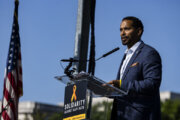What first was imagined as a “Bicycle Beltway” has evolved into a transportation plan for walkers and bikers approved by D.C.-area leaders in order to create seamless paths for travel regionwide.
The National Capital Trail Network was approved by the Metropolitan Washington Council of Governments’ Transportation Planning Board on Wednesday.
Some 656 miles of paths that currently exist represent about one-third of the plan’s final goal that has a target completion date of 2045.
The network of off-street paths is intended to be used for trips far away and close to home, for transportation and recreation for people of all ages and abilities.
The footprint extends as far north as Frederick County in Maryland, west to Loudoun County in Virginia, south to Prince William County in Virginia and into Charles County in Maryland.
More than 4 million people now live within a half-mile of the planned network, and that number promises to grow.
The goal is for people to have options for walking and biking as reliable, inexpensive, healthy modes of transportation, according to COG transportation planner Michael Farrell.
After the measure was approved, Farrell told WTOP about a European cartoon that shows members of an American cycling club loading bikes onto SUVs before driving away.
“Instead of this just being something where people put a bike on the back of a car they’ll drive to a park and then ride around in a circle, we want people to be able to get places,” Farrell said.
But he said right now the infrastructure doesn’t exist.
“It’s incomplete, or it dumps you on a hostile road where you would never want to take your kids,” Farrell said.
Jurisdictions have intentions to try to execute plans for the network.
“These are all projects that are already in local plans,” Farrell said. “And, there’s already a right of way in existence. We’re not just drawing lines on a map and saying: ‘Wouldn’t it be cool if somebody could ride this way?”
In Falls Church, for example, the Washington and Old Dominion Railroad bike trail has become so popular the city recently funded the creation of a parallel path for pedestrians to increase capacity and add room for safety. The W&OD extends from the inner suburbs of Northern Virginia to west of Leesburg and into Purcellville.
“The city of Falls Church, as other jurisdictions are committed to making sure this plan doesn’t just sit on a shelf, but becomes a plan and a resource for the public,” Falls Church City Council Member Dave Snyder said.
Increasing capacity of trails is important, “especially now during the pandemic time,” Snyder said.
Bringing the network to fruition won’t rely entirely upon public money.
“In a region that is still growing rapidly, I think we can get a lot of this built with developer dollars,” Farrell said.
The network paths are intended for speeds not to exceed 20 mph with nonmotorized equipment, but the TPB does not have a position on use by e-bikes or motorized scooters that localities are free to decide upon independently.








